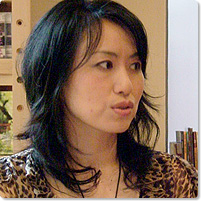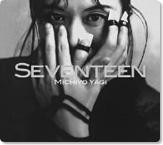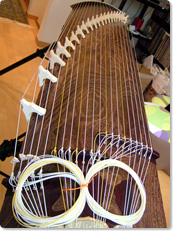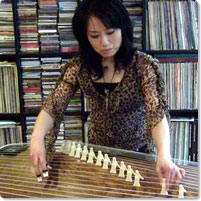- Listening to your performances has changed my image of the koto as a “traditional instrument.” Your music has dynamism and you seem to cross so easily from one genre into another, achieving different ethnic and instrument sounds. How did you begin to play the koto?
-
My mother was the local koto teacher in our town. I guess I first became involved with it because of that proximity, and I’m very grateful for that. However, when I was a child I thought my mother played an unusual kind of music. What we learned in music class at school was the seven-note scale of Western music. We don’t learn the 5-note scale that most traditional Japanese music is based on. In our music textbook there was one song,
Haru no Umi
(Spring Sea) by the Japanese composer Michio Miyagi, but our teacher just skipped over that page, saying that it wasn’t important. Still at an impressionable young age, this incident implanted a complex about Japanese music in my mind, and the koto became an instrument I wanted to avoid when I was little.
Still, I remember being made to practice for a couple of days to learn the basic piece Sakura just before one of my mother’s student recitals so I could perform with them. This was not a good thing, because it gave me the idea that this was a kind of music that could easily be played with a minimum of practice. At that age, I didn’t know, for instance, that there are in fact many subtle nuances and interesting sounds that can be created between the notes E and F. I thought that it was an easy kind of music to play once the tunings were worked out. That was another reason I didn’t like the koto at first.
Nevertheless, it seemed my mother wanted me to become a musician, and she had me studying piano two hours a day from about the age of five, sitting right beside me as I practiced. Compared to that, I wasn’t playing the koto much. I think my mother first started teaching me koto when I was about four, and even at that time I was trying different tunings so that I could play the melodies to the songs I heard on the TV, or records, or songs from cartoon shows, and famous classical music themes like Beethoven’s “Pastorale.” Figuring out how to play the music I heard on the koto was one of my favorite childhood pastimes. - So how did the instrument you “wanted to avoid” as a child eventually become your lifetime pursuit?
-
When I was in high school I happened to hear Teiko Kikuchi playing “First Movement of a Suite for Solo 17-string Koto” by Toshiya Sukekawa on an NHK FM radio contemporary music program. I wasn’t at a very high level in terms of koto technique at that time, but I thought that this was a piece I wanted to perform. It was something completely fresh and different from anything I had ever heard.
So I finally became serious about studying the koto, but at this point my mother decided that there was a limit to what she could impart in terms of technique and that I needed to study with someone else, because a mother-child teaching environment wouldn’t be strict enough. So it was decided that I would study under Satomi Kurauchi, who was one of Tadao Sawai’s apprentices. A year after I started studying with Mrs. Kurauchi, she was about to have a child and took that opportunity to arrange for me to take lessons once a month from Mr. Sawai in Tokyo. That was a real culture shock for me. - Tadao Sawai is known as one of the foremost innovators in the koto world. Not just an outstanding performer but also an outstanding composer. He did a lot of innovative work in search of truly contemporary koto music and opened up new territory in contemporary music. He also founded the Sawai Koto School with his wife and fellow performer Kazue to teach the next generation of musicians. So you were taking lessons from him at a time when he was at the height of his creative powers. And this opportunity came when you were at a very impressionable age in your late teens.
- I was moved by the powerful sense of drive in Mr. Sawai’s playing, and it was the first time I realized that koto music could be so powerfully moving, so “driven.” What always seemed to me an old instrument suddenly became an instrument that drove straight into my heart. After a while, Mrs. Kazue Sawai invited me to live at their home and study full-time. That’s how I became a live-in apprentice. Once I entered the apprenticeship I became completely absorbed in my studies and, before I knew it, two years had passed.
- Today there are few inner-circle apprentices who are with their teacher 24 hours a day. Most of them commute from their own homes to the master’s studio and assist the master and receive instruction during the day. What was life as an apprentice like?
-
To tell the truth, I had no idea what was involved when Mrs. Sawai asked me if I wanted to become an apprentice. I just thought it meant living with the master and his family and being able to listen to his teachings and hear him perform all the time and have meals together and such. But when I actually moved in, I found out that we apprentices had to make these meals (
laughs
). Since there were always lots of guests and students coming and going, we were making dinner for more than 10 people every evening.
There were also many other things we had to do for the master, like preparing the instruments for lessons and performances, running errands and such. It wouldn’t be until about midnight that I finally had time to do my own practicing, and by then I was so sleepy. I was at the bottom in terms of apprentice seniority, but my seniors were kind and helpful. There were nights when they would allow me to practice while they were sleeping in the same room. - There must be some things that you only could have learned by being a live-in apprentice.
- Mr. And Mrs. Sawai were busy with concerts and teaching, so there was little time for them to teach us apprentices. So I would listen to Mr. Sawai teach other students, listen to him practice, and watch how he prepared himself backstage. There were other kinds of lessons to be learned, such as the art of turning ingredients into fine meals. In other words, it was not a place where I learned things like technique from an external framework, but rather a place where I was able to absorb the internal aspects of being a koto performer. I think all the things I learned at that time are being put to use in my career today. For example, the proper mental attitude when one is about to play the koto, or the importance of creating a “place” of your own in music.
- So you begin to search for your own place with the koto?
-
Yes. And that work continues to this day. The first really big hint came to me in 1989 when I performed at New York’s Bang on a Can Festival as an accompanist for Kazue Sawai. One of John Cage’s latest works was performed, a piece which involved all different sizes of tin plates positioned all around the hall, and a group of these macho men beating on them. It created a maelstrom of sound, with interacting rhythms overwhelming the hall. Here were professionals from the music world as well as ordinary folks from the neighborhood, listening together to this piece by a great contemporary composer. I was simply amazed to see music functioning as entertainment in such a way. This was when I began thinking that, if I was going to continue playing the koto, I should aspire to a music that is not bound to genres. At that time, even as I practiced the existing repertoire, I was always full of ideas about how I would do a piece if I were performing on my own. It was around that time that I began to think that I might be better suited to the task of creating my own music, though I knew it might not be easy.
Two years later I was invited to teach koto as a guest instructor at the Ethnomusicology Department that John Cage started at Wesleyan University in the USA. That was another culture shock. The university had four performance halls, and every Saturday and Sunday there would be performances of new works by the students. There were collaborations of music and film, there were lots of pieces that went beyond the realm of “music,” and it was very stimulating to me to see how these works were presented not as special performances but as the natural extension of the daily presentation of work that was going on. I realized how important the creative process is to art. During the year that I was there, I began to get an increasing number of requests to perform new works. I performed pieces by Christian Wolff and John Zorn, and began to receive more and more information about different types of music. In part it was evidence that I had finally gotten used to being in this new place. I was enjoying each day and I didn’t want to go back to the closed world of Japan. But at the same time I had my doubts. If I stayed in the U.S. without having ever really mastered the classical repertoire of the koto, would I be able to return to Japan when I reached 30 or so and make it as a solo performer? This led to my decision to return to Japan and start from scratch. - Wasn’t it rare at that time in Japan’s koto world to find performers like you who were intent on creating “your own world of music?”
-
Around me, there was no one else of my generation who shared my thoughts, and no one was doing it. Around the time the Kronos Quartet became popular, I was playing in a quartet with three other women of kindred spirit, and like Kronos we were playing new works on commission. Presently I am playing with four bands besides Kokoo, and I find this situation very rewarding because I’m able to express aspects of my own music in all of them. However, I believe that these activities are possible only because I am first and foremost an independent solo performer of my own music. So I’ll continue to place special importance on my solo work.
When playing in ensembles with other Western instruments, the koto has a sonic range that’s neither here nor there compared to other Japanese instruments like the shakuhachi for the shamisen. And if you try to imitate the styles of other stringed instruments such as the guitar or the piano, you’re bound to end up displaying the deficiencies of the koto as a musical instrument. It is the kind of instrument that you have to approach from the standpoint of the things that only a koto can do and the qualities that only the koto has to offer. Without this point of view, the only impression the koto leaves is one of imperfection.
There is also the problem of pitch that is common to all Japanese instruments.
Ordinarily, the pitch of the koto will begin to drop during performance. During a concert, heat from stage lights as well as humidity causes the strings to slightly stretch and the pitch begins to go flatter. This is an important point of concern for someone like me who often plays in ensembles with Western instruments. I can adjust the bridges to raise the pitch, or continue playing as is—when playing a blues there it can actually be more effective to have a reduced interval between E and F—or I can change the nuance of the pitch by pressing down on the string. One needs to make on-the-spot decisions about these things.
However, when I am playing own music solo, none of the instrument’s imperfections have an adverse effect. Solo performances of my own compositions, where everything can be approached positively, will continue to be the foundation of my activities as a musician.
Another of the appeals of the koto is that, although most people associate it with a particular tonal quality, there is actually quite a diverse range of sounds you can get out of it. We tested it once using ProTools and found out that fluctuations in temperature and humidity produce quite a bit of change in the waveforms of its sound, which means that it is quite an interesting instrument in terms of its sensitivity to natural phenomenon such as weather. Besides that, we discovered that different performers produce quite different waveforms. The sound is affected by the way the picks hit the strings—the attack, the angle, the shape of the player’s fingers, even the physical qualities of the finger bones. Also, there is the fact that the koto uses open tuning. You can create your own tunings of the koto just by moving the bridges. Even with the basic pentatonic scale of traditional Japanese music, you can still create your own nuances in the tuning. It’s a fascinating instrument in that the process of preparing the instrument for performing, that is, tuning, already reflects your individuality.
In his essay for the program notes of my album Seventeen , the music critic Manabu Yuasa wrote: “One is amazed by the sheer variety of the cell structures of the wild creatures that live in Michiyo Yagi’s koto. These cells grow by feeding on the reverberations of the strings and come out at night to cause all sorts of mischief. And that is why, in this album, you will hear the laughter of demons–big/medium/small demons, blue demons, white demons, red demons.” I believe that the unique character of the koto enables it to “harbor demons” and with the right kind of playing they can be unleashed. - Nonetheless, don’t you still have problems with the instability of the pitch and the volume limitations of the koto when you play with musicians of non-traditional instruments or when playing with foreign artists overseas?
-
I commissioned electric kotos and no longer have volume issues–I can be heard virtually anywhere under any circumstances.
Lately I’ve been enjoying musical communication through improvisation with musicians I’ve met for the first time. If I have about 20 minutes of rehearsal time with another musician, I can usually work out some tunings and go right into a performance. During a quick sound check, I’ll think about what kind of environment this person comes from, what he or she listens to, what kind of musical education he or she had, how that relates to their music, and all this helps to create the actual performance. It’s great fun.
Many foreign musicians want to play with traditional Japanese musicians when they come to Japan, and I often do improvisation sessions with these artists. There are times when some of the typical qualities of the koto, like the fact that the pitch gradually starts to go down, can actually bring an unexpected element of tension to the performance that works in positive ways. What’s most attractive about a collaboration with a visiting artist who knows nothing about the background of the koto are the various pressures I encounter which force me to transcend the structural limitations of the instrument. - You seem to be performing the traditional koto repertoire as well lately. Where do you think you are headed now in terms of finding a “place” of your own music that you mentioned earlier?
-
About seven years ago I was asked to play a folk ballad named
Yuki
(Snow) with a shamisen artist. I took that opportunity to listen to a lot of recordings, but they didn’t communicate anything more than the musical score, so the performances sounded like mere formalities. Just when I had decided how I should play it, I happened to find a videotaped performance by the late Hatsuko Kikuhara, who was a designated “Living National Treasure.” It was the same piece,
Yuki
, and yet it was completely different. Thinking about how it could sound so unique, I suddenly realized something about her posture. She was sitting flat on the floor like an old grandma, bending forward slightly from the base of the backbone. The way she wore her kimono was different too. Not tight and high up on the ribs like it’s usually worn today, but lower and with the collar looser so she could sit very relaxed as she played. I realized this was part of the reason that she could play with such expression and nuance. Surely this was authentic traditional playing. In traditional performance technique you usually let the noise of the picks on the strings be heard, and if you vary the angle of the picks depending on the amount of pressure on the strings, you can control the amount of noise you produce. I realized that with a posture as relaxed as Kikuhara, you can get a sound out the koto that is like the sound of the wind.
I have played many different kinds of music, from the traditional repertoire to contemporary music and improvisational music, but if I were to describe what kind of musician I want to become, I would say “a genre unto myself.” Whether you’re hearing me improvising or playing traditional music, I want you to hear “me.” That is the very least that I aspire to. This spring I happened to see an exhibition of the works of Katsushika Hokusai at the Smithsonian Institute in Washington D.C. Looking at his portraits of women, I noticed how simple the compositions were, with no unnecessary flourish, and the backgrounds looked distant and yet were depicted with great clarity. There was something to enjoy in every part of the work. I began thinking: How wonderful it would be to be able to do the same with music. Or to be even more ambitious, my ultimate goal is to create music resembling the ancient scroll paintings of samurai battle scenes. The musical story unfolds horizontally through time, like a scroll. And yet, at any one moment during the performance, the musical design and quality is sophisticated and clear, like an individual scene in a scroll painting. That is the kind of music I aspire to in my solo work.
Michiyo Yagi
A unique world of koto music connecting points and lines Koto Musician Michiyo Yagi

Michiyo Yagi
Koto player Michiyo Yagi was born in Tokoname City, Aichi Prefecture and studied with Satomi Kurauchi, ,Tadao Sawai and Kazue Sawai. She began performing professionally in the latter half of the 1980’s. During her tenure as Visiting Professor of Music at Wesleyan University in the USA, she premiered numerous modern compositions for koto and was influenced by composers such as John Cage and John Zorn. Her most recent recordings include Seventeen , an album of original compositions entirely played on the 17-string bass koto. Says her husband and producer Mark E. Rappaport: “Keeping in mind that the koto may be extinct in a hundred years’ time, it’s important that Michiyo play her own music, and I believe she’s quite aware of that. After having done quite a lot of different things in the past, she’s now on the verge of combining diverse elements into a unique music of her very own.” Yagi is planning to release three to four CDs between July 2006 and next spring.
Interviewer: Kazumi Narabe

Michiyo Yagi
Seventeen
(Zipangu ZIP-0019)


Related Tags

